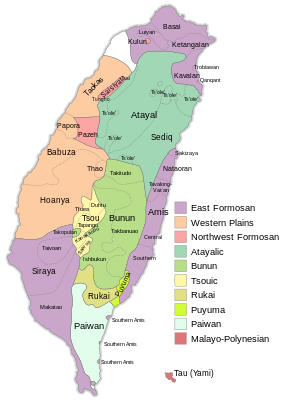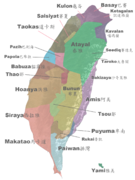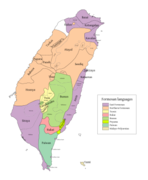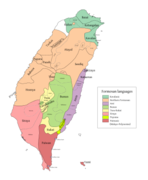| Formosan | |
|---|---|
| (geographic) | |
| Geographic distribution | |
| Ethnicity | Taiwanese Aborigines (Formosan people) |
| Linguistic classification | Austronesian
|
| Subdivisions |
|
| Language codes | |
| ISO 639-5 | fox |
| Glottolog | None |
 Families of Formosan languages before Chinese colonization, per Blust (1999). Malayo-Polynesian (red) may lie within Eastern Formosan (purple).
The white section is unattested; some maps fill it in with Luiyang, Kulon or as generic 'Ketagalan'. Families of Formosan languages before Chinese colonization, per Blust (1999). Malayo-Polynesian (red) may lie within Eastern Formosan (purple).
The white section is unattested; some maps fill it in with Luiyang, Kulon or as generic 'Ketagalan'. | |
The Formosan languages are a geographic grouping comprising the languages of the indigenous peoples of Taiwan, all of which are Austronesian. They do not form a single subfamily of Austronesian but rather up to nine separate primary subfamilies. The Taiwanese indigenous peoples recognized by the government are about 2.3% of the island's population. However, only 35% speak their ancestral language, due to centuries of language shift. Of the approximately 26 languages of the Taiwanese indigenous peoples, at least ten are extinct, another four (perhaps five) are moribund, and all others are to some degree endangered. They are national languages of Taiwan.
The aboriginal languages of Taiwan have great significance in historical linguistics since, in all likelihood, Taiwan is the place of origin of the entire Austronesian language family. According to American linguist Robert Blust, the Formosan languages form nine of the ten principal branches of the family, while the one remaining principal branch, Malayo-Polynesian, contains nearly 1,200 Austronesian languages found outside Taiwan. Although some other linguists disagree with some details of Blust's analysis, a broad consensus has coalesced around the conclusion that the Austronesian languages originated in Taiwan, and the theory has been strengthened by recent studies in human population genetics.
Recent history
Main article: Taiwanese indigenous peoplesAll Formosan languages are slowly being replaced by the culturally dominant Taiwanese Mandarin. In recent decades the Taiwan government started an aboriginal reappreciation program that included the reintroduction of Formosan first languages in Taiwanese schools. However, the results of this initiative have been disappointing.
In 2005, in order to help with the preservation of the languages of the indigenous people of Taiwan, the council established a Romanized writing system for all of Taiwan's aboriginal languages. The council has also helped with classes and language certification programs for members of the indigenous community and the non-Formosan Taiwanese to help the conservation movement.
Classification
Main article: Austronesian languages § ClassificationFormosan languages form nine distinct branches of the Austronesian language family (with all other Malayo-Polynesian languages forming the tenth branch of the Austronesian).
List of languages
It is often difficult to decide where to draw the boundary between a language and a dialect, causing some minor disagreement among scholars regarding the inventory of Formosan languages. There is even more uncertainty regarding possible extinct or assimilated Formosan peoples. Frequently cited examples of Formosan languages are given below, but the list should not be considered exhaustive.
Living languages
| Language | Code | No. of dialects |
Dialects | Notes |
|---|---|---|---|---|
| Amis | ami | 5 | 'Amisay a Pangcah, Siwkolan, Pasawalian, Farangaw, Palidaw | |
| Atayal | tay | 6 | Squliq, Skikun, Ts'ole', Ci'uli, Mayrinax, Plngawan | high dialect diversity, sometimes considered separate languages |
| Bunun | bnn | 5 | Takitudu, Takibakha, Takivatan, Takbanuaz, Isbukun | high dialect diversity |
| Kanakanavu | xnb | 1 | moribund | |
| Kavalan | ckv | 1 | listed in some sources as moribund, though further analysis may show otherwise | |
| Paiwan | pwn | 4 | Eastern, Northern, Central, Southern | |
| Puyuma | pyu | 4 | Puyuma, Katratripul, Ulivelivek, Kasavakan | |
| Rukai | dru | 6 | Ngudradrekay, Taromak Drekay, Teldreka, Thakongadavane, 'Oponoho | |
| Saaroa | sxr | 1 | moribund | |
| Saisiyat | xsy | 1 | ||
| Sakizaya | szy | 1 | ||
| Seediq | trv | 3 | Tgdaya, Toda, (Truku) | |
| Thao | ssf | 1 | moribund | |
| Truku | trv | 1 | ||
| Tsou | tsu | 1 | ||
| Yami/Tao | tao | 1 | also called Tao. Linguistically, not a member of the "Formosan languages", but a Malayo-Polynesian language. |
- Although Yami is geographically in Taiwan, it is not classified as Formosan in linguistics.
Extinct languages
| Language | Code | No. of dialects |
Dialects | Extinction date & notes |
|---|---|---|---|---|
| Basay | byq | 1 | Mid-20th century | |
| Babuza | bzg | 3? | Babuza, Takoas, Favorlang (?). | Late 19th century. Ongoing revival efforts. |
| Kulon | uon | 1 | Mid-20th century | |
| Pazeh | pzh | 2 | Pazeh, Kaxabu | 2010. Ongoing revival efforts. |
| Ketagalan | kae | 1 | Mid-20th century | |
| Papora | ppu | 2? | Papora, Hoanya (?). | |
| Siraya | fos | 2? | Siraya, Makatao (?). | Late 19th century. Ongoing revival efforts. |
| Taivoan | tvx | 1 | Late 19th century. Ongoing revival efforts. |
Grammar
Verbs typically are not inflected for person or number, but do inflect for tense, mood, voice and aspect. Formosan languages are unusual in their use of the symmetrical voice, in which a noun is marked with the direct case while the verb affix indicates its role in the sentence. This can be seen as a generalisation of the active and passive voices, and is considered a unique morphosyntactic alignment. Furthermore, adverbs are not a unique category of words, but are instead expressed by coverbs.
Nouns are not marked for number and do not have grammatical gender. Noun cases are typically marked by particles rather than inflecting the word itself.
In terms of word order, most Formosan languages display verb-initial word order—VSO (verb-subject-object) or VOS (verb-object-subject)—with the exception of some Northern Formosan languages, such as Thao, Saisiyat, and Pazih, possibly from influence from Chinese.
Li (1998) lists the word orders of several Formosan languages.
- Rukai: VSO, VOS
- Tsou: VOS
- Bunun: VSO
- Atayal: VSO, VOS
- Saisiyat: VS, SVO
- Pazih: VOS, SVO
- Thao: VSO, SVO
- Amis: VOS, VSO
- Kavalan: VOS
- Puyuma: VSO
- Paiwan: VSO, VOS
Sound changes
Tanan Rukai is the Formosan language with the largest number of phonemes with 23 consonants and 4 vowels containing length contrast, while Kanakanavu and Saaroa have the fewest phonemes with 13 consonants and 4 vowels.
Wolff
The tables below list the Proto-Austronesian reflexes of individual languages given by Wolff (2010).
| Proto-Austronesian | Pazih | Saisiat | Thao | Atayalic |
|---|---|---|---|---|
| *p | p | p | p | p |
| *t | t, s | t, s, ʃ | t, θ | t, c (s) |
| *c | z | h | t | x, h |
| *k | k | k | k | k |
| *q | Ø | ʔ | q | q, ʔ |
| *b | b | b | f | b- |
| *d | d | r | s | r |
| *j | d | r | s | r |
| *g | k-, -z- , -t | k-, -z- , -z | k-, -ð-, -ð | k- |
| *ɣ | x | l (> Ø in Tonghœʔ) | ɬ | ɣ, r, Ø |
| *m | m | m | m | m |
| *n | n | n | n | n |
| *ŋ | ŋ | ŋ | n | ŋ |
| *s | s | ʃ | ʃ | s |
| *h | h | h | Ø | h |
| *l | r | l (> Ø in Tonghœʔ) | r | l |
| *ɬ | l | ɬ | ð | l |
| *w | w | w | w | w |
| *y | y | y | y | y |
| Proto-Austronesian | Saaroa | Kanakanavu | Rukai | Bunun | Amis | Kavalan | Puyuma | Paiwan |
|---|---|---|---|---|---|---|---|---|
| *p | p | p | p | p | p | p | p | p |
| *t | t, c | t, c | t, c | t | t | t | t, ʈ | tj , ts |
| *c | s, Ø | c | θ, s, Ø | c ( in Central & South) | c | s | s | t |
| *k | k | k | k | k | k | k, q | k | k |
| *q | Ø | ʔ | Ø | q (x in Ishbukun) | ɦ | Ø | ɦ | q |
| *b | v | v | b | b | f | b | v | v |
| *d | s | c | ḍ | d | r | z | d, z | dj , z |
| *j | s | c | d | d | r | z | d, z | dj , z |
| *g | k-, -ɬ- | k-, -l-, -l | g | k-, -Ø-, -Ø | k-, -n-, -n | k-, -n-, -n | h-, -d-, -d | g-, -d-, -d |
| *ɣ | r | r | r, Ø | l | l | ɣ | r | Ø |
| *m | m | m | m | m | m | m | m | m |
| *n | n | n | n | n | n | n | n | n |
| *ŋ | ŋ | ŋ | ŋ | ŋ | ŋ | ŋ | ŋ | ŋ |
| *s | Ø | s | s | s | s | Ø | Ø | s |
| *h | Ø | Ø | Ø | Ø | h | Ø | Ø | Ø |
| *l | Ø | Ø, l | ñ | h-, -Ø-, -Ø | l | r, ɣ | l | l |
| *ɬ | ɬ | n | ɬ | n | ɬ | n | ɬ | ɬ |
| *w | Ø | Ø | v | v | w | w | w | w |
| *y | ɬ | l | ð | ð | y | y | y | y |
| Proto-Austronesian | Tagalog | Chamorro | Malay | Old Javanese |
|---|---|---|---|---|
| *p | p | f | p | p |
| *t | t | t | t | t |
| *c | s | s | s | s |
| *k | k | h | k | k |
| *q | ʔ | ʔ | h | h |
| *b | b | p | b, -p | b, w |
| *d | d-, -l-, -d | h | d, -t | ḍ, r |
| *j | d-, -l-, -d | ch | j, -t | d |
| *g | k-, -l-, -d | Ø | d-, -r-, -r | g-, -r-, -r |
| *ɣ | g | g | r | Ø |
| *m | m | m | m | m |
| *n | n | n | n | n |
| *ŋ | ŋ | ŋ | ŋ | ŋ |
| *s | h | Ø | h | h |
| *h | Ø | Ø | Ø | Ø |
| *l | l | l | l | l |
| *ɬ | n | ñ, n, l | l-/ñ-, -ñ-/-n-, -n | n |
| *w | w | w | Ø, w | w |
| *y | y | y | y | y |
Blust
The following table lists reflexes of Proto-Austronesian *j in various Formosan languages (Blust 2009:572).
| Language | Reflex |
|---|---|
| Tsou | Ø |
| Kanakanavu | l |
| Saaroa | ɬ (-ɬ- only) |
| Puyuma | d |
| Paiwan | d |
| Bunun | Ø |
| Atayal | r (in Squliq), g (sporadic), s (sporadic) |
| Sediq | y (-y- only), c (-c only) |
| Pazeh | z () (-z- only), d (-d only) |
| Saisiyat | z () |
| Thao | z () |
| Amis | n |
| Kavalan | n |
| Siraya | n |
The following table lists reflexes of Proto-Austronesian *ʀ in various Formosan languages (Blust 2009:582).
| Language | Reflex |
|---|---|
| Paiwan | Ø |
| Bunun | l |
| Kavalan | ʀ (contrastive uvular rhotic) |
| Basay | l |
| Amis | l |
| Atayal | g; r (before /i/) |
| Sediq | r |
| Pazeh | x |
| Taokas | l |
| Thao | lh (voiceless lateral) |
| Saisiyat | L (retroflex flap) |
| Bashiic (extra-Formosan) | y |
Lenition patterns include (Blust 2009:604-605):
- *b, *d in Proto-Austronesian
- *b > f, *d > c, r in Tsou
- *b > v, *d > d in Puyuma
- *b > v, *d > d, r in Paiwan
- *b > b, *d > r in Saisiyat
- *b > f, *d > s in Thao
- *b > v, *d > r in Yami (extra-Formosan)
Distributions
Gallery
-
 The Formosan languages
The Formosan languages
-
 The Formosan languages, per Blust (1999)
The Formosan languages, per Blust (1999)
-
 The Formosan languages, per Li (2008)
The Formosan languages, per Li (2008)
-
 The Formosan languages, per the Austronesian Basic Vocabulary Database (Greenhill, Blust & Gray 2008).
The Formosan languages, per the Austronesian Basic Vocabulary Database (Greenhill, Blust & Gray 2008).
-
 The Formosan languages, per Ross (2009)
The Formosan languages, per Ross (2009)
Information
Li (2001) lists the geographical homelands for the following Formosan languages.
- Tsou: southwestern parts of central Taiwan; Yushan (oral traditions)
- Saisiyat and Kulon: somewhere between Tatu River and Tachia River not far from the coast
- Thao: Choshui River
- Qauqaut: mid-stream of Takiri River (Liwuhsi in Chinese)
- Siraya: Chianan Plains
- Makatau: Pingtung
- Bunun: Hsinyi (信義鄉) in Nantou County
- Paiwan: Ailiao River, near the foot of the mountains
See also
- Cognate sets for Formosan languages (Wiktionary)
- Demographics of indigenous Taiwanese
- Writing systems of Formosan languages
- Personal pronoun systems of Formosan languages
- Fossilized affixes in Austronesian languages
- Proto-Austronesian language
- Tsou language for an example of the unusual phonotactics of the Formosan languages
- Sinckan Manuscripts
- Naming customs of Taiwanese indigenous peoples
References
Citations
- "Táiwān yuánzhùmín píngpǔ zúqún bǎinián fēnlèi shǐ xìliè dìtú" 臺灣原住民平埔族群百年分類史系列地圖 (A history of the classification of Plains Taiwanese tribes over the past century). blog.xuite.net (in Chinese). 2009-08-06. Retrieved 2017-03-04.
- Sui, Cindy (2010-07-14). "Taiwan Seeks to Save Indigenous Languages". BBC News.
- ^ Zeitoun, Elizabeth; Yu, Ching-Hua (2005). "The Formosan Language Archive: Linguistic Analysis and Language Processing". International Journal of Computational Linguistics and Chinese Language Processing. 10 (2): 167–200. doi:10.30019/ijclclp.200507.0002. S2CID 17976898.
- Li, Paul Jen-kuei; Tsuchida, Shigeru (2006). Kavalan Dictionary (PDF) (in English and Chinese). Taipei: Institute of Linguistics, Academia Sinica. ISBN 9789860069938. Archived from the original (PDF) on 2021-05-03.
- "Indigenous Languages Development Act". law.moj.gov.tw. Archived from the original on 13 February 2019. Retrieved 22 May 2019.
- Blust, Robert (1999). "Subgrouping, Circularity and Extinction: Some Issues in Austronesian Comparative Linguistics". In Zeitoun, Elizabeth; Li, Jen-kuei (eds.). Selected Papers from the Eighth International Conference on Austronesian Linguistics. Taipei: Academia Sinica. ISBN 9789576716324.
- Diamond, Jared M. (2000). "Taiwan's Gift to the World". Nature. 403 (6771): 709–710. Bibcode:2000Natur.403..709D. doi:10.1038/35001685. PMID 10693781. S2CID 4379227.
- Fox, James (19–20 August 2004). Current Developments in Comparative Austronesian Studies. Symposium Austronesia, Pascasarjana Linguististik dan Kajian Budaya Universitas Udayana. ANU Research Publications. Bali. OCLC 677432806.
- Trejaut, Jean A; Kivisild, Toomas; Loo, Jun Hun; et al. (2005). "Traces of Archaic Mitochondrial Lineages Persist in Austronesian-Speaking Formosan Populations". PLOS Biology. 3 (8): e247. doi:10.1371/journal.pbio.0030247. PMC 1166350. PMID 15984912.
- Huteson, Greg (2003). Sociolinguistic Survey Report for the Tona and Maga Dialects of the Rukai Language (PDF) (Report). Dallas, TX: SIL International. Archived from the original (PDF) on 2013-09-05.
- Hsu, Jenny W. (2010-06-07). "Aboriginal Language Classes Open to Public". Focus Taiwan. Archived from the original on 2014-11-29 – via galdu.org.
- Yuánzhùmínzú yǔyán yánjiū fāzhǎn zhōngxīn (2018). Yuánzhùmínzú yǔyán shūxiě xìtǒng jiànyì xiūzhèng bǎnběn bàogào 原住民族語言書寫系統建議修正版本報告 (PDF) (Report) (in Chinese).
- Li & Tsuchida (2006).
- Li, Paul Jen-kuei. (1998). "Táiwān nándǎo yǔyán 台灣南島語言 ." In Li, Paul Jen-kuei. (2004). Selected Papers on Formosan Languages. Taipei, Taiwan: Institute of Linguistics, Academia Sinica
- Blust (2009), p. 165
- Wolff, John U. (2010). Proto-Austronesian Phonology with Glossary. Ithaca, NY: Cornell Southeast Asia Program Publications.
- There are several outcomes of *g as onset or coda of the final syllable.
- Li, Paul Jen-kuei (2001). "The Dispersal of the Formosan Aborigines in Taiwan" (PDF). Languages and Linguistics. 2 (1): 271–278. Archived from the original (PDF) on 2020-08-08. Retrieved 2020-06-02.
Sources
- Blust, Robert A. (2009). The Austronesian languages. Canberra: Pacific Linguistics, Research School of Pacific and Asian Studies, Australian National University. ISBN 978-0-85883-602-0. OCLC 320478203.
Further reading
- Blundell, David (2009), Austronesian Taiwan: Linguistics, History, Ethnology, Prehistory. Taipei, Taiwan: SMC Publishing
- Happart, G., & Hedhurst, W. H. (1840). Dictionary of the Favorlang dialect of the Formosan language. Batavia: printed at Parapattan.
- Li, Paul Jen-kuei (2004). "Basic Vocabulary for Formosan Languages and Dialects." In Li, Paul Jen-kuei. Selected Papers on Formosan Languages, vol. 2. Taipei, Taiwan: Institute of Linguistics, Academia Sinica.
- Mackay, G. L. (1893). Chinese Romanized Dictionary of the Formosan Vernacular. Shanghai: Presbyterian Mission Press. OCLC 47246037.
- Tsuchida, S. (2003). Kanakanavu texts (Austronesian Formosan). .
- Zeitoun, E. (2002). Nominalization in Formosan languages. Taipei: Institute of Linguistics (Preparatory Office), Academia Sinica.
External links
- Ogawa's Vocabulary of Formosan Dialects 小川尚義 (臺灣蕃語蒐録)
- Academia Sinica's Formosan Language Archive project
- Linguistics and Formosan Languages
- Yuánzhùmínzú yǔyán xiànshàng cídiǎn 原住民族語言線上詞典 (in Chinese) – "Aboriginal language online dictionary" website of the Indigenous Languages Research and Development Foundation
- Zú yǔ E lèyuán 族語E樂園 (in Chinese) – Educational site maintained by Taiwan's Council of Indigenous Peoples
- T.A.I.W.A.N. – Taiwan-Austronesion Indigenous Words and Narrations – English counterpart of Zú yǔ E lèyuán
- Map: Formosan Languages and Yami (PDF)
| Formosan languages | |||||||
|---|---|---|---|---|---|---|---|
| East |
| ||||||
| Northern |
| ||||||
| Tsouic |
| ||||||
| Others | |||||||
| |||||||
| Austronesian languages | |||||||||||||||||||||||||||||||||
|---|---|---|---|---|---|---|---|---|---|---|---|---|---|---|---|---|---|---|---|---|---|---|---|---|---|---|---|---|---|---|---|---|---|
| Formosan | |||||||||||||||||||||||||||||||||
| Malayo-Polynesian |
| ||||||||||||||||||||||||||||||||
| |||||||||||||||||||||||||||||||||